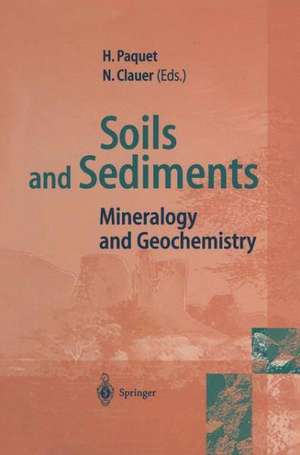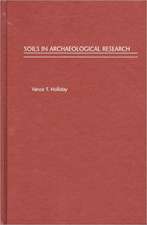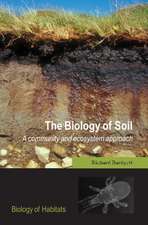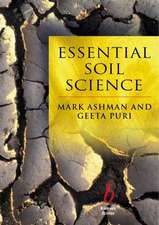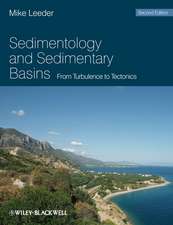Soils and Sediments: Mineralogy and Geochemistry
Editat de Helene Paquet, Norbert Claueren Limba Engleză Paperback – 5 oct 2011
Preț: 1361.35 lei
Preț vechi: 1660.18 lei
-18% Nou
Puncte Express: 2042
Preț estimativ în valută:
260.65€ • 271.42$ • 216.26£
260.65€ • 271.42$ • 216.26£
Carte tipărită la comandă
Livrare economică 13-27 februarie
Preluare comenzi: 021 569.72.76
Specificații
ISBN-13: 9783642644436
ISBN-10: 3642644430
Pagini: 392
Ilustrații: XX, 369 p.
Dimensiuni: 155 x 235 x 21 mm
Greutate: 0.55 kg
Ediția:Softcover reprint of the original 1st ed. 1997
Editura: Springer Berlin, Heidelberg
Colecția Springer
Locul publicării:Berlin, Heidelberg, Germany
ISBN-10: 3642644430
Pagini: 392
Ilustrații: XX, 369 p.
Dimensiuni: 155 x 235 x 21 mm
Greutate: 0.55 kg
Ediția:Softcover reprint of the original 1st ed. 1997
Editura: Springer Berlin, Heidelberg
Colecția Springer
Locul publicării:Berlin, Heidelberg, Germany
Public țintă
ResearchDescriere
Clays and soils are of great importance in various scientific fields, such as agriculture and environmental science, and in mineral deposits. Students and close collaborators of Georges Millot, the eminent French clay sedimentologist, have put together a book with topics ranging from weathering processes and diagenetic evalution of sediments to sedimentary mineral deposits. The book is of interest to practitioners, advanced students as well as teachers in the above fields.
Cuprins
1 Clay Minerals in Weathered Rock Materials and in Soils.- 1 Introduction.- 2 Hydrolytic Weathering Processes and Genesis of Secondary Constituents.- 2.1 TheConceptof intensity of Hydrolysis»:Certainties and Limitations.- 2.2 Introduction to the Concept of “Degree ofWeathering” MajorTypes of Weathering.- 2.3 Conditions for the Formation of Alterite and Arena.- 3 Pedological Clay Minerals: Nature and Characterization.- 3.1 Clays of the Kaolin Group (Low-Activity Clays).- 3.2 Charged Clays of the 2/1 Group (High-Activity Clays).- 3.2.1 The High-Charged Category (z=0.8-0.9).- 3.2.2 The Low-Charged Category (z Conclusions.- 7 Calerete and Geochemistry of Landscapes.- 7.1 Rectification of the Basement.- 7.2 Pedological Action and Ablation.- 7.3 Integration of the Processes.- 8 Calcretes and Paleoenvironments.- 8.1 Pedogenesis and WaterTable Diagenesis.- 8.2 Paleocalcretes:Jebel Chambi (Tunisia).- 8.3 Paleoenvironmental Consequences.- 9 Conclusions v..- References.- 3 Laterites and Bauxites.- 1 Introduction.- 2 Formation of the Original Bauxites.- 2.1 Weathering of the Parent Rock.- 2.2 Transfers and Accumulation in Isalterites.- 3 Evolution of the Original Bauxites: Formation of Degraded Bauxites.- 3.1 Evolution of the Original Bauxites Under Humid Climates.- 3.2 Evolution of Bauxites under Tropical Climates with Alternating Seasons.- 3.3 Evolution of the Bauxites Under Semi-Arid Climates.- 4 Mass Balances of the Different Evolutions.- 4.1 The Lakota Bauxites, Ivory Coast.- 4.2 The PortoTrombetas Bauxites,Brazil.- 5 Alteration Rate and Age of Bauxites.- 6 Evolution of the Bauxite Landscapes.- 7 Conclusion.- References.- 4 Geochemical Processes in Tropical Landscapes: Role of the Soil Covers.- 1 Introduction.- 2 Soil Covers in Dynamic Equilibrium.- 2.1 “Eutrophic” Brown Soils and Vertisols on Migmatites of the Sudanian Tropical Zone of West Africa.- 2.2 Soil Covers Consisting ofTropical Ferruginous Soils.- 2.3 Soil Covers with Iron Crusts.- 2.4 Soil Covers consisting of Red Ferrallitic Soils.- 2.5 Soil Covers consisting ofYellow Ferrallitic Soils.- 3 Soil Covers in Chemical Disequilibrium (Transformation Systems).- 3.1 Transformation Systems in Africa between Sahara and the Humid Tropical Zone.- 3.1.1 SurficialTransformation Systems: Eluviation-Erosion Shift.- 3.1.2 InternalTransformation Systems.- 3.1.2.1 LateralTransferSystems.-Eluvial-llluvial Systems.- 3.1.2.2 In Situ Reorganized Systems.- 3.2 Transformation Systems in the HumidTropical Zone.- 3.2.1 Ferrallitic Soil-PodzolTransformation Systems.- 3.2.1.1 In the Manaus Area, Brazil.- 3.2.1.2 In French Guyana.- 3.2.1.3 In the Basin of the Upper Rio Negro.- 3.2.2 Transformation Systems on Basement with Drainage Inversion.- 4 Conclusions.- References.- 5 Evolution of Lateritic Manganese Deposits.- 1 Introduction.- 2 Example of the Moanda (Gabon) Sedimentary Manganese Deposit Enriched by Lateritization.- 2.1 Description of the Deposits.- 2.2 Stratified Deposit or Alterite?The Search for the «Protore».- 2.3 Mineralogy and Geochemistry of the Protore.- 2.4 Supergene Weathering: Formation and Evolution of the Ore.- 2.4.1 The Parent Rock and its Development Towards the Surface.- 2.4.2 The Base Layer.- 2.4.3 The Plaquette Horizon.- 2.4.4 The Upper Horizons:Transition and Pisolite Levels.- 2.5 Conclusion.- 3 Comparison with Other Manganese Deposits.- 3.1 The Azul Deposit.- 3.2 Sites with Lateritic Alteration on Metamorphic Protore (Queluzites)..- 3.2.1 The West African Deposits.- 3.2.2 The Lafaiete Deposit of Brazil.- 4 Conclusion.- References.- 6 The Lateritic Nickel-Ore Deposits.- 1 Geochemical Characteristics of Nickel.- 1.1 Nickel in Endogenous Conditions.- 1.2 Nickel in Exogenous Conditions.- 2 Nickel-Ore Deposits.- 3 Petrology of Lateritic Weathering Profiles on Ultrabasic Rocks.- 4 Geochemical Interpretation of the Evolution of Weathering Profiles.- 4.1 Geochemical Balance ofVertical Profiles.- 4.2 Control of the Geochemical Evolution.- 4.3 Evolution of the Landscapes.- 5 Discussion: Role of the Weathering Factors in the Formation of Deposits.- 5.1 Role of the Bedrock and the Geological Context.- 5.2 Climate Dependence.- 5.3 Time Dependence.- 6 Conclusion.- References.- 7 The Behavior of Gold in the Lateritic Alterosphere.- 1 Introduction.- 2 Chemical and Mineralogical Properties of Gold.- 3 The Precambrian Gold Lithosphere and its Weathering.- 4 Gold Behavior in Natural Supergene Systems.- 4.1 The Mobility of Gold issued from Parental Sulfides.- 4.2 The Mobility of Gold under s.s. Lateritic Environments.- 4.3 Latentes in a Humid Equatorial Climate:the Gabon Example.- 5 Conclusions and Perspectives.- References.- 8 Comparative Ecology of Two Semi-Arid Regions: the Brazilian Sertäo and the African Sahel.- 1 Introduction.- 2 Ecological Parameters.- 2.1 Geographical Frame.- 2.2 Climate.- 2.3 Geological Framework.- 2.4 Landforms and Hydrological Frame.- 2.5 Soils.- 2.6 Vegetation.- 2.7 Human Environment.- 3 Discussion.- 3.1 Similarities and Differences in the Ecological Parameters.- 3.2 Consequences on Runoff and Infiltration.- 3.3 Consequences for Surface Water Quality.- 3.4 Consequences for Soil Erosion.- 3.5 Consequences for the Functioning Ecosystem.- 3.5.1 The Caatinga Ecosystem.- 3.5.2 The “BrousseTigrée”Ecosystem.- 4 Conclusion.- References.- 9 Importance of the Pore Structures During the Weathering Process of Stones in Monuments.- 1 Introduction.- 2 Progressive Understanding of the Alteration of Stones in Monuments.- 3 The First Studies on Sandstones in France.- 4 Alteration Morphologies and Parameters governing their Development.- 5 Pore Structures.- 6 Water Balance and Stone Weathering.- 7 Conclusion.- References.- 10 Continental Silicifications: A Review.- 1 Introduction.- 2 The Geological Data and their Interpretation.- 2.1 Pedogenic Silicifications.- 2.1.1 Quartzose Silcretes: Relative Silica Accumulation.- 2.1.1.1 Profile Structure.- 2.1.1.2 Structure Interpretation.- 2.1.1.3 Palaeogeographical Framework.- 2.1.1.4 Tepetates: Beginning Silcretization?.- 2.1.2 Hardpans: Absolute Silica Accumulation.- 2.1.2.1 Structures of the Profiles.- 2.1.2.2 Micromorphology and Chemistry.- 2.1.2.3 Structure Interpretation.- 2.1.2.4 Hardpans and Duripans in Modern Landscapes.- 2.1.3 Mechanisms of Pedogenic Silicifications.- 2.2 Groundwater Silicifications.- 2.2.1 Sandstone Silicificatiomthe Fontaipebleau Sandstones.- 2.2.1.1 Silcrete Distribution and Deep Weathering.- 2.2.1.2 Silicification by Groundwater Outflow.- 2.2.1.3 Discussion.- 2.2.2 Claystone Silicificatiomthe AustralianTertiary Regolith.- 2.2.2.1 Description.- 2.2.2.2 Interpretation.- 2.2.3 Limestone Silicificatiomthe Limestone Plateaus of the Paris Basin.- 2.2.3.1 Description on the Silicified Limestones.- 2.2.3.2 Interpretation and Mechanisms.- 2.2.4 Variability of the Groundwater Silicifications.- 2.3 Silicifications associated with Evaporites.- 2.3.1 The Modern Evaporitic Environments.- 2.3.1.1 Salt Lake Deposits.- 2.3.1.2 Brine Geochemistry.- 2.3.2 Sulphate Replacements in Geological Formations.- 2.3.3 Discussion.- 3 Mechanisms at Work.- 3.1 The Geochemical Rules.- 3.1.1 Silica Solubility.- 3.1.1.1 Solubility in Brines.- 3.1.1.2 Complexation:Dissolution in Saturated Solution.- 3.1.2 Mineral Sequences.- 3.2 The Crystal Growth Rules.- 3.2.1 Crystal Nucleation and Growth.- 3.2.1.1 Quartz Precipitation.- 3.2.1.2 Petrographic Facies.- 3.2.2 Recrystallization.- 3.2.3 Epigenetic Replacements.- 4 Conclusions.- References.- 11 Clay Minerals,Paleoweathering, Paleolandscapes and Climatic Sequences:The Paleogene Continental Deposits in France.- 1 Introduction.- 2 Landscapes and Regoliths at the End of the Cretaceous.- 3 The Siderolithic Discharge.- 3.1 Formation of the “Argües Plastiques”.- 3.1.1 The Mottled Clays.- 3.1.2 The Kaolinitic Clays.- 3.1.3 Origin of the Clays.- 3.2 Extension of the «Siderolithic» Facies.- 3.3 Paleolandscapes.- 4 The Indurated Landscapes.- 4.1 PedogeneticSilcretes.- 4.2 Calcretes.- 4.3 Encrusted Paleolandscapes.- 5 Pre-Evaporitic Clay Minerals in Restricted Basins.- 5.1 In Southeastern France.- 5.2 In the Paris Basin.- 5.3 Geochemical Mechanisms.- 5.4 Paleolandscapes and Mechanisms.- 6 Geochemical Sequence of Climatic Origin.- 6.1 Development of theWeathering Mantles.- 6.2 Landscape Disruption.- 6.3 LandscapeTransformation.- 6.4 Evaporitic Accumulations.- 6.5 Sequence Polarity.- 7 Conclusion.- References.- 12 On the Genesis of Sedimentary Apatite and Phosphate-Rich Sediments.- 1 Introduction.- 2 Apatite Synthesis.- 3 Genesis of Sedimentary Apatite.- 3.1 From Experiment to Nature.- 3.2 Natural Apatite.- 4 Genesis of Phosphorites and Phosphate-Rich Sequences.- 5 Conclusion: A Model for Phosphogenesis.- References.- 13 Clay Mineral Sedimentation in the Ocean.- 1 Introduction.- 2 Sedimentary Formatron and Destruction of Clay Minerals.- 2.1 In Alkaline Evaporitic Environments.- 2.2 In Organic Environments.- 2.3 In Clay Granular Environments.- 2.4 In Deep-Sea Metalliferous Clay Environments.- 2.5 In Volcanic and Hydrothermal Environments.- 3 Detrital Supply and Diagenesis of Clay Minerals.- 3.1 Terrigenous Input in Modern Oceans.- 3.2 The Origin of Smectite in Old Common Marine Sediments.- 3.2.1 Classical Potential Origins.- 3.2.2 A Case Study:The Smectites of the Atlantic Ocean.- 3.2.3 Smectite and Sea-Level Changes.- 3.3 Diagenesis with Increasing Burial Depth.- 3.4 OtherDiageneticConstraints.- 4 Preservation and Destruction of the Paleoenvironmental Record of Marine Sedimentary Clay.- 4.1 Paleoclimate.- 4.2 Past Continental Sources, Paleocirculations andTectonics.- 4.3 Progressive Obliteration of Paleoenvironmental Messages by Diagenesis.- References.- 14 Revisited Isotopic Dating Methods of Sedimentary Minerals for Stratigraphic Purpose.- 1 Introduction.- 2 Some Fundamentals.- 2.1 Analytical Aspects.- 2.2 Mineral Phases suitable for Isotopie Dating.- 2.3 Influence of Particle Size and Temperature on Isotopie Dates.- 2.4 Concept of Isotopie Homogenization.- 3 Examplesof Isotopie Dating of Clay Minerals.- 3.1 Rb-Sr and K-Ar Dating.- 3.2 Sm-Nd Dating.- 3.3 40Ar/39Ar Dating.- 4 Isotopie Dating of Non-Clay Minerals.- 4.1 Dating by Reference to the SecularVariation of Marine Sr.- 4.2 Pb-Pb Dating of Carbonates.- 5 Conclusion.- References.- 15 Concomitant Alteration of Clay Minerals and Organic Matter during Burial Diagenesis.- 1 Introduction.- 2 Maturation Stages of Organic Matter.- 2.1 The Oil Window.- 2.2 TheVitrinite Reflectance.- 2.3 The Dispersed Organic Matter.- 3 Mineral Alterations.- 3.1 The Disappearance of Swelling Layers.- 3.2 Definition of theTransition Zone.- 3.3 Relationship betweenTransition Zone,Depth andTemperature.- 3.4 Relationship between Smectite/IlliteTransition,Overpressure and Organic Maturation.- 3.5 Stability-Instability of Smectite.- 4 Conclusions.- References.
